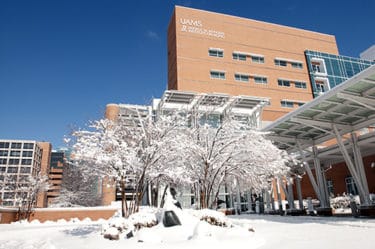UAMS Earns Tree Campus USA Status from Arbor Day Foundation
| For the seventh consecutive year, the Arbor Day Foundation recognized the main campus of UAMS as a Tree Campus USA 2019.
Penny Talbert, landscape manager in UAMS Campus Operations, said she was grateful for the recognition of the effort she and the team she leads have put into maintaining a health population of trees on the urban campus.
To obtain this distinction, the university met the foundation’s five core standards, including having a tree advisory committee, following a campus tree-care plan, dedicating annual expenditures for its campus tree program, publicly observing Arbor Day and sponsoring student service learning projects.
“Your entire campus community should be proud of your sustained commitment to environmental stewardship,” Dan Lambe, Arbor Day Foundation president, stated in a letter to UAMS Chancellor Cam Patterson, M.D., MBA.
Talbert said the effort to become a Tree Campus began in 2010, and it took several years of effort to earn the recognition, first granted in 2013.
“I try to plant trees every year,” she said. “We did an inventory in 2016, and we have more than 800 trees on campus. That changes with every bad storm that comes through. Since I’ve been here we’ve planted about 360 trees. Some have been with projects like Ray Winder Field.”
One area getting much of the attention of Talbert and her team is the $150 million energy project under construction on the campus’ east side between Pine and Cedar streets. To clear land for the project, several dozen rent houses were demolished and even more trees were cut down in the yards of those properties.

Even in a dormant state for the winter, trees near the UAMS Medical Center prove they can still stand out under the right conditions.
Talbert said she hated to see the trees go, but she also understands the need for the power plant. Many of the trees there were in bad health, she added.
Plans call for 178 trees to be planted once the project is closer to completion, a net gain of several dozen trees over the number lost because of the new construction. Some may be put in place in the next one to two years. Several blocks of Cedar Street will be closed as part of the project, and Pine Street will be expanded into a boulevard with a 16-foot median the university will maintain and plant with several dozen trees.
Talbert and her team look at projects like the power plant as opportunities to expand the tree population. That awareness has helped UAMS keep its Tree Campus USA status.
Unlike some universities, UAMS is home to a wide variety of trees and tree species, Talbert said. Planting many trees of one kind would put the campus at a higher risk of losing large sections to a disease or blight. Even if a species become vulnerable to a disease or pest, it’s less likely that all the trees would become vulnerable to it because of the diversity of the overall population. The UAMS main campus also is home to some special habitats for trees and other plant life.
“We have some special, little microclimates in several places, so we can grow some things that are different,” Talbert said. “Like down in the Cancer Institute, the healing garden there rarely gets cold. There are a lot of challenges on the campus, too, but those challenges are great opportunities to learn more.”
Construction of walking trails and an outdoor fitness court in the redeveloped Cedar-Pine corridor isn’t too far off, and Talbert is looking forward to planting new trees there.
“When I am gone from here in 15-20 years, I want it to still look better,” she said. “Gardeners plan for the future.”
